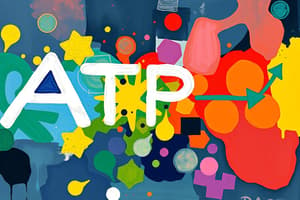Podcast
Questions and Answers
Which phase of glycolysis consumes 2 ATP?
Which phase of glycolysis consumes 2 ATP?
- Isomerization of DHAP
- Formation of ATP from 1,3bisphosphoglycerate & ADP
- Energy investment phase (correct)
- Energy generation phase
What is the end product under anaerobic conditions in glycolysis?
What is the end product under anaerobic conditions in glycolysis?
- CO2 & H2O
- Glyceraldehyde 3-phosphate
- Pyruvate
- Lactate (correct)
Which molecule is formed from the oxidation of glyceraldehyde 3-phosphate in aerobic conditions?
Which molecule is formed from the oxidation of glyceraldehyde 3-phosphate in aerobic conditions?
- Lactate
- NADH
- CO2 & H2O
- Pyruvate (correct)
Substrate-level phosphorylation occurs in which phase of glycolysis?
Substrate-level phosphorylation occurs in which phase of glycolysis?
What is the main function of aldolase in glycolysis?
What is the main function of aldolase in glycolysis?
Which type of phosphorylation involves the direct transfer of a phosphate group to ADP to form ATP?
Which type of phosphorylation involves the direct transfer of a phosphate group to ADP to form ATP?
Which enzyme is responsible for the synthesis of ATP from 1,3-bisphosphoglycerate in glycolysis?
Which enzyme is responsible for the synthesis of ATP from 1,3-bisphosphoglycerate in glycolysis?
In oxidative phosphorylation, where does the transfer of electrons from reduced coenzymes to molecular oxygen occur?
In oxidative phosphorylation, where does the transfer of electrons from reduced coenzymes to molecular oxygen occur?
Which step of glycolysis involves the conversion of 3-phosphoglycerate to 2-phosphoglycerate?
Which step of glycolysis involves the conversion of 3-phosphoglycerate to 2-phosphoglycerate?
What type of phosphorylation is characterized by the formation of high-energy phosphate bonds through the cleavage of a high-energy metabolic intermediate?
What type of phosphorylation is characterized by the formation of high-energy phosphate bonds through the cleavage of a high-energy metabolic intermediate?
Which enzyme is responsible for generating phosphoenol pyruvate (PEP) from 2-phosphoglycerate?
Which enzyme is responsible for generating phosphoenol pyruvate (PEP) from 2-phosphoglycerate?
What is the major difference between oxidative phosphorylation and substrate-level phosphorylation?
What is the major difference between oxidative phosphorylation and substrate-level phosphorylation?
Which enzyme catalyzes the reversible interconversion of dihydroxyacetone phosphate (DHAP) and glyceraldehyde 3-phosphate?
Which enzyme catalyzes the reversible interconversion of dihydroxyacetone phosphate (DHAP) and glyceraldehyde 3-phosphate?
Which enzyme converts Glyceraldehyde 3-phosphate to 1,3-bisphosphoglycerate in the glycolysis pathway?
Which enzyme converts Glyceraldehyde 3-phosphate to 1,3-bisphosphoglycerate in the glycolysis pathway?
Which of the following is a product of the reaction that converts Glyceraldehyde 3-phosphate to 1,3-bisphosphoglycerate?
Which of the following is a product of the reaction that converts Glyceraldehyde 3-phosphate to 1,3-bisphosphoglycerate?
In the glycolysis pathway, which step involves the split of Fructose 1,6-bisphosphate into two three-carbon compounds?
In the glycolysis pathway, which step involves the split of Fructose 1,6-bisphosphate into two three-carbon compounds?
Which compound is important for the formation of both NADH +H+ and a high-energy compound during glycolysis pathway?
Which compound is important for the formation of both NADH +H+ and a high-energy compound during glycolysis pathway?
In glycolysis, how many ATP molecules are synthesized by oxidative phosphorylation after NADH passes through the Electron Transport Chain (ETC)?
In glycolysis, how many ATP molecules are synthesized by oxidative phosphorylation after NADH passes through the Electron Transport Chain (ETC)?
Study Notes
Formation of ATP from 1,3-Bisphosphoglycerate and ADP
- 1,3-Bisphosphoglycerate is converted to ATP and 3-Phosphoglycerate by the enzyme phosphoglycerate kinase in Step 7 of glycolysis.
- This reaction is a substrate-level phosphorylation, which is reversible.
- This is the first ATP generation step in glycolysis.
Phosphorylation
- Phosphorylation is the metabolic reaction of introducing a phosphate group into an organic molecule.
- There are two types of phosphorylation: substrate-level phosphorylation and oxidative phosphorylation.
- Oxidative phosphorylation occurs in the mitochondria and involves the formation of high-energy phosphate bonds by phosphorylation of ADP to ATP, coupled to the transfer of electrons from reduced coenzymes to molecular oxygen via the electron transport chain.
- Substrate-level phosphorylation occurs in the cytosol or mitochondria and involves the formation of high-energy phosphate bonds by phosphorylation of ADP to ATP, coupled to cleavage of a high-energy metabolic intermediate.
Isomerization of 3-Phosphoglycerate and Dehydration of 2-Phosphoglycerate
- 3-Phosphoglycerate is converted to 2-Phosphoglycerate by phosphoglycerate mutase in Step 8.
- 2-Phosphoglycerate is converted to phosphoenol pyruvate (PEP) by the enzyme enolase in Step 9.
Phosphorylation of Fructose 6-P and Splitting of F1,6 BP
- Fructose 6-phosphate is phosphorylated to Fructose 1, 6-bisphosphate by phosphofructokinase (PFK) in Step 3.
- The PFK reaction is irreversible and rate-limiting.
- Fructose 1, 6-bisphosphate is split to glyceraldehyde 3-phosphate and dihydroxy acetone phosphate by the enzyme aldolase (Fructose 1, 6-bisphosphate aldolase) in Step 4.
Isomerization of DHAP and Oxidation of Glyceraldehyde 3P
- Dihydroxy acetone phosphate is converted to glyceraldehyde 3-phosphate by phosphotriose isomerase in Step 5.
- Glyceraldehyde 3-phosphate is converted to 1,3-bisphosphoglycerate by glyceraldehyde 3-phosphate dehydrogenase in Step 6.
Energy Generation Phase and Overall Process of Glycolysis
- The energy generation phase (Payoff Phase) consists of the last 5 reactions of glycolysis.
- In aerobic conditions, 2 pyruvate, 4 ATP, and 2 NADH are produced from 2 molecules of glyceraldehyde 3-phosphate.
- In anaerobic conditions, only 4 ATP are generated with the conversion of 2 pyruvate to 2 lactate, and 2 NADH do not enter the electron transport chain.
- Glycolysis occurs in the absence of oxygen (anaerobic) or in the presence of oxygen (aerobic) in the presence of mitochondria.
- Glucose is the universal fuel for human cells, and its sources include the diet and internal glycogen stores.
Studying That Suits You
Use AI to generate personalized quizzes and flashcards to suit your learning preferences.
Description
Learn about the seventh step in glycolysis where phosphoglycerate kinase enzyme acts on 1,3-bisphosphoglycerate to produce ATP and 3-phosphoglycerate. This step involves substrate-level phosphorylation and marks the first ATP generation step in glycolysis.




